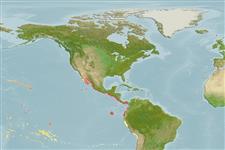Actinopterygii (ray-finned fishes) >
Perciformes (Perch-likes) >
Serranidae (Sea basses: groupers and fairy basslets) > Serraninae
Etymology: Diplectrum: Greek, di = two + Greek, plektron = sting, spur (Ref. 45335). More on author: Jordan.
Environment / Climate / Range
Ecology
Marine; demersal; depth range 15 - 150 m (Ref. 9342), usually 60 - 90 m (Ref. 9342). Tropical, preferred ?; 32°N -
Eastern Pacific: Gulf of California to Peru; including the Galapagos Islands.
Size / Weight / Age
Maturity: Lm ? range ? - ? cm
Max length : 20.0 cm TL male/unsexed; (Ref. 9342); common length : 15.0 cm TL male/unsexed; (Ref. 55763)
Body elongate, not very deep, and little compressed, its depth contained 3.2 to 3.8 times in standard length; caudal peduncle very thick; preopercular angle with a broad "spur" consisting of 6 to 12 large spines; first gill arch with 21 to 27 gill rakers; anal rays 8; body grayish brown; flanks with indistinct dark, double, vertical bars; snout and cheeks with yellow stripes; soft dorsal fin with a dark band along its base (Ref. 55763).
Inhabits sand or muddy-sand bottoms. Probably too small in size to be of commercial importance.
Life cycle and mating behavior
Maturity | Reproduction | Spawning | Eggs | Fecundity | Larvae
Heemstra, P.C., 1995. Serranidae. Meros, serranos, guasetas, enjambres, baquetas, indios, loros, gallinas, cabrillas, garropas. p. 1565-1613. In W. Fischer, F. Krupp, W. Schneider, C. Sommer, K.E. Carpenter and V. Niem (eds.) Guia FAO para Identification de Especies para lo Fines de la Pesca. Pacifico Centro-Oriental. 3 Vols. FAO, Rome. (Ref. 9342)
IUCN Red List Status (Ref. 115185)
CITES (Ref. 94142)
Not Evaluated
Threat to humans
Harmless
Human uses
Fisheries: of no interest
More information
Common namesSynonymsMetabolismPredatorsEcotoxicologyReproductionMaturitySpawningFecundityEggsEgg development
ReferencesAquacultureAquaculture profileStrainsGeneticsAllele frequenciesHeritabilityDiseasesProcessingMass conversion
Tools
Special reports
Download XML
Internet sources
